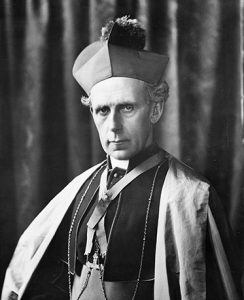The Real Archbishop Mannix from the Sources
by James Franklin, Gerald O. Nolan and Michael Gilchrist (Connorcourt Publishing, AUS$29.95)
Twelve biographies of Archbishop Daniel Mannix have already been published. They range from the hagiographic to the critical. The authors justify this addition to the list on the grounds that it is an account of Mannix based on his own words. And his own words were often very fiery and controversial.
Mannix was born near Charleville, Co. Cork, on November 6, 1864. Following his training in St Patrick’s College, Maynooth, he was ordained on June 9, 1890. He was a member of the staff of his alma mater from 1891 to 1903 and its president from 1903 to 1912, when he was consecrated coadjutor archbishop of Melbourne, succeeding in 1917 on the death of Archbishop Thomas Carr.
The Australia to which Mannix arrived in 1913 was a deeply divided society. There was a majority – English and Protestant which in effect was an ascendancy – and a minority – a disenfranchised working-class, most of whom were Irish Catholics.
Then there was the Loyal Orange Institution and the Protestant Federation, who were determined to ensure that this status quo should remain permanent.
With his instinctive commitment to justice the fearless Mannix was unable to ignore this challenge. Thus almost from the outset of his sojourn in Australia in his public statements he was confrontational, controversial and at times even inflammatory.
Education was an ever-recurring theme in his major addresses. He was critical of various governments’ refusal to aid Catholic schools, reminding them that Catholics paid their taxes like everyone else and so were entitled to a just proportion of the state expenditure on education. By a curious coincidence, as he lay dying, a policy to grant state-aid to all schools was initiated and at present Australia has one of the most generous systems of public funding of Church schools in the world.
The authors perceptively note that the memories Mannix and his fellow-countrymen in Australia had of centuries of British oppression in Ireland were revived by the execution of the leaders of the Easter Rising in 1916. This caused them to doubt the claim that the Great War, which began in 1914, was fought to ensure the freedom and independence of small nations.
Led by Mannix they opposed conscription when the government sought to introduce it in two referenda. Mannix even went on to urge Australians to put “Australia before the Empire” and described World War I as “an ordinary trade war”.
Despite his distance from Ireland, the struggle for independence in his homeland was never far from Mannix’s mind. As the struggle intensified from 1916 onwards so did his support for it. Eventually by virtue of his addresses to the Irish diaspora in Australia, US and the UK in the period from 1920 to 1925 he became an Irish Republican icon.
Teaching
Mannix admired the social teaching of the papal encyclicals Rerum Novarum and Quadragesimo Anno. The encyclicals attempted to steer a middle course between capitalism and communism, rejecting the inequities of laissez faire capitalism and communism’s denial of the right to private property.
“Let the Church approve no social order” he once said “…in which there is a great discrepancy between the luxury and wealth of a privileged few, and the wretchedness and material indigence of the many” – a sample of “his own words” which many might still reflect on.
Mannix set out to promote Catholic social teaching and to this end he was assisted by the charismatic B. A. Santamaria. Their aim was to persuade the leadership of the Australian Labour Party to incorporate it into their core policies. After some limited initial success they failed.
However, they continued their efforts and the result was a disastrous split in the ALP, which kept it out of office for 17 years. As the authors state, Mannix is seen in his poorest light through the lens of this involvement in the internal politics of the ALP.
It is appropriate that the last word be given to a successor of Mannix, Cardinal George Pell, who wrote that he was the most influential churchman in Australian history. He was all that, and as is clear from this fine study for 50 years, he was the undisputed leader of Irish diaspora in that country and an outstanding Australian patriot.



